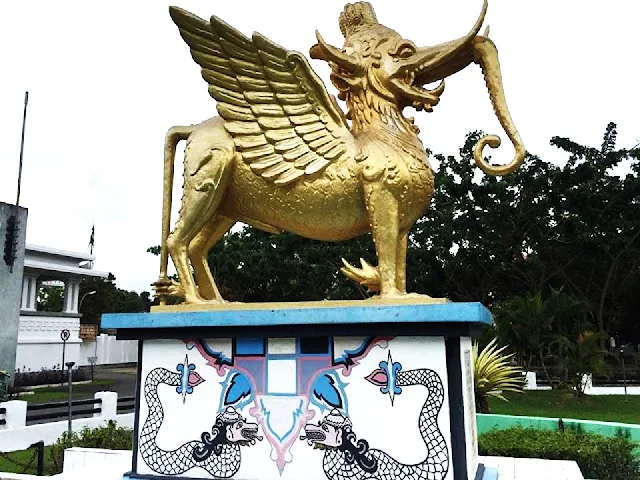Lembuswana: Symbol of the Kutai Martadipura Kingdom
 |
| The awe-inspiring statue of Lembuswana, full of myth and legend. Photo documentation: the author. |
BORNEOTRAVEL - TENGGARONG: When planning or by chance you find yourself in Borneo, don't miss Tenggarong and the Mulawarman Museum.
It's the premier historical destination in the Nusantara, housing the oldest inscriptions dating back to the late 4th or early 5th century AD.
Prominently displayed at the Mulawarman Museum is the peculiar creature known as Lembuswana.
What exactly is this creature that symbolizes the oldest kingdom in the Nusantara, Kutai Martadipura?
The awe-inspiring statue of Lembuswana, full of myth and legend
In front of the replica of Lembuswana. At the brink of an evening. As twilight began to envelop the Mulawarman Museum area, Tenggarong, East Kalimantan.
Gazing forward. Facing across. Eyes pass over smooth asphalt roads. Alongside the Mahakam River. Its endless flow of water.
We can imagine. Ages ago. Hindus arrived on the shores of Borneo. Surely not by flying iron birds. But navigating the waters. For months. Even years. Crossing the open seas. Conquering vast oceans separating nations. Surrounded by seas that would later become part of the Nusantara region.
How did Hindus from India come here?
Bringing not only goods but also beliefs. Including customs, religion, and education.
If we study closely, the entire story behind Lembuswana is educational. Regardless of its origin.
The main point is that the folklore behind it teaches values, including chivalry, courage, teaching, and loyalty to leaders.
Aren't these values universal? Aren't they an accumulation of values we are currently experiencing a crisis in?
So, touring the Mulawarman Museum is like a pilgrimage. Visitors will surely feel a retreat. Refreshing their national insights.
We are reminded of human values. Wrapped within the replica of Lembuswana.
How did outsiders enter the Nusantara region? Bringing an entire culture (7 aspects of life according to Krober and Kluckhohn) and we adopted it? Not just adopted. The foreign culture has hegemonized all aspects of our lives throughout the centuries, even today? While we willingly accept it. Without questions, let alone objections?
Looking towards the banks of the Mahakam River. Piercing the imaginary boundary. Minds wander. Far beyond the horizons of the past. Crossing barriers of space and time.
This place was believed to be a stopover
Once upon a time. This place was believed to be a stopover. Besides being an international trade route.
After crossing the Makassar Strait, through the Philippines, and China. So much so that the Kutai Kingdom prospered. Its people lived in peace. Its economy flourished from trade.
Inside the museum. There are many pieces of evidence that can narrate all this. There, a replica of the Yupa Inscription stands. I've taken pictures of it. And asked the guards about the history of its discovery.
According to historical records, the first ruler of the Kutai Kingdom was a figure named Kudungga. Kudungga is believed to have started his important role as a tribal chief in that area.
However, history records that significant changes in Kutai's governance structure occurred due to Hindu influence. This can be explained by the significant transformation in culture and governance systems adopted from Hindu beliefs.
As a result, Kutai's governance structure changed into a more organized kingdom.
Kudungga, the local king who sat on the throne of the Kutai Kingdom, is believed to be a native of Varuna-dvipa, later known as the island of Borneo.
The origin of this naming shows deep historical roots in this region. Kudungga was a significant figure in the early development of this kingdom and is considered one of the first rulers to establish Kutai as a strong governmental entity on the island of Borneo.
This change, from tribal chiefdom to a Hindu-influenced kingdom, was a crucial step in Kutai's historical development. It reflects how culture and religion played a key role in changing governance structures in the past.
Important parts of Borneo's historical legacy
Kudungga and the Kutai Kingdom are important parts of Borneo's historical legacy, which played a significant role in shaping this region.
That's the essence of the Yupa Inscription.
Historians. History teachers. History enthusiasts. And those curious about the history of Nusantara, like myself. It feels incomplete without stepping foot, experiencing firsthand the historical realm of the Kutai Kingdom.
Why? Because in ancient texts, it is always written that "Kutai Martadipura is the oldest Hindu kingdom in Nusantara."
It is said that Kutai Martadipura existed around the 4th century AD. Reflections are still long along the banks of the Mahakam River.
Values: remain steadfast
So many questions swirl in my mind. For example: Oh... history can indeed change, reverse course, from age to age. Rulers can rise and fall.
Dynasties and clans will succeed each other. But values: remain steadfast. Eternal.
In the past, this territory was ruled by locals. Then Hinduism. Then the influence of Islam. Then this. And then that.
And a century ahead? 500 years hence? And a thousand years more?
-- Masri Sareb Putra, M.A.





